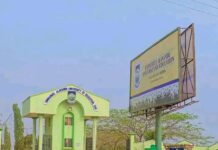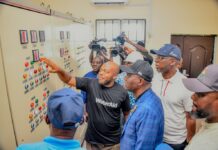
If there is any programme of the President Muhammadu Buhari administration that has enjoyed the most attention, spiced with unfair criticisms – hinged mostly on beer parlour facts – it is the Conditional Cash Transfer Programme (CCT). Once again, as if the pattern is scheduled for every two to three years, it is under the eye of the public and media. Sadly those who quickly put pen to paper attacking the what and how of the programme have the barest idea how it works. All too often, this has been the case whenever its activities are publicised. It is not new. And it scarcely would be the end of the scrutiny.
By the very nature of the programme, its beneficiaries, the unbanked, those without social media accounts, or smartphones in fact, without an education, the poorest of the poor, who cannot make a case for themselves on Politics Today with Seun Okinbaloye, or AITs Kaakaki, or NTA’s Good Morning Nigeria, cannot give the accurate picture of the manner the program affects their lives.
Even when they are captured on amateur lenses, made to prove that these kinds of people are real, their expressions lack coherence. Maybe the sheer joy, maybe the confusion and shyness that comes with camera lenses, mostly, they are unlearned and find the expressions of emotions formed after the cash gift difficult. They leave it at the realm of prayer, and tears.
The poorest of the poor, have a life that cannot be appreciated by the rich – even the middle class seldom can fathom it.
The doling of cash to them, in fair sums, has been established as a tried and reliable strategy to begin the journey of lifting them out of poverty – side-by-side conditions that demand they learn skills to make better utility of the cash. Ultimately, their lives are improved. Education, though not the most fantastic quality, is achievable for their offspring. Improved healthcare with its attendant hopes of reduced maternal and child mortality are possible. All these, through putting more disposable income in the hands of the poorest of our population.
The question is how are these ‘poorest of the poor’ selected. Many ask, and wonder too, why they are not the ones receiving this cash. By their self-assessment they are poor too. But this is a state of affairs that not many would proudly glorify. A cursory look at our lives and the challenges we face, when compared with others is enough to remind us of the Christian Hymnal: “count your blessings, name them one by one, count your blessings see what God hath done … and it will surprise you what the Lord hath done.” Indeed. We are much better to do than most, and there is the abundant population who see our basic needs – gadgets, the internet and television subscriptions, sweet tooth cravings, fuel in our cars and the likes – as unaffordable luxuries.
As soon as the COVID 19 pandemic became a clear threat to the nation, President Buhari announced the lockdown of 3 major cities that accounted for a majority of the coronavirus cases in the country. That invariably meant putting a stop to day-to-day businesses in these hubs. Artisans, cobblers, hawkers, plumbers, mechanics and the likes whose pay-day is by the daily hustle have been hard it. Worse affected have been the poor – who lack even the day to day jobs these listed have. They fend off from the crumbs of crumbs, having no assets, skills or sources of income. These categories of people are those who make up the National Social Register built over time by the National Social Safety Nets Coordinating Office (NASSCO). How NASSCO identifies these people is scarcely known in the public space. Many have conjectured and assumed different ways they are done. A recent piece I read assumed the data was sent in by Community Heads. But that is not so. The only role the Community Heads play in the building of this data is being the first points of contact when NASSCO’s Community Based Targeting teams visit the community for their enumeration. As is the protocol for any such communal engagements, they inform him, respectfully.
Poverty means different things to different communities. In one community not possessing farmlands could be defined as being poor, in another not having zinc roofs or children in school is the definition. This is the concept that NASSCO uses through the Community Based Targeting (CBT) model – a system where the community identifies what poverty means to them and who consequently is poor among them. This method is age-long, and was introduced to the Nigerian developmental space by the Word Bank about a decade ago.
When the NASSCO CBT team arrive a community to identify those who would make up their register, they share the community into three focus groups: the youth, the women and the men. Each cluster is asked what poverty means to them, and who they identify as poor among them. The households that are common to each cluster are those who eventually make the list of poor households for the National Social Register. Two people – a man and a woman – are afterwards nominated by the community to sign off on this list. Their role, beyond signing off, includes ensuring that the list is not tinkered with.
The NASSCO is different from the Conditional Cash Transfer programme. But NASSCO’s social register is what the CCT use to identify those who make its own payment list. The National Social Register is available to government and its partners where they seek to implement programmes and projects. The CCT, a programme of government, is one of such programmes that enjoys from the ready work of NASSCO’s register. It employs what is known as the Proxy Means Test: a method that ranks the estimated household incomes by weighing the value of household assets and other proxies – like assets, number and age range of family members, education levels, and enrolment in schools, housing characteristics, durable goods like fridges and televisions, among others to ascertain potential income. Using an algorithm, it ranks them and picks those who fall below the 6th decile as the poorest of the poor to make up its own payment register.
Doling out physical cash and not through Bank payments, as is the case with Cash transfers, may seem unattractive, even medieval. But when dealing with extremely poor people, we cannot use our same parameters of transactions to engage them. They mostly do not have the luxury of owning bank accounts – and paying the attendant transactional charges which they cannot afford; neither do most of their communities have any nearby commercial deposit banks. The best and most helpful thing to do is to pay them at the place most convenient for them – in cash. These payments are made through verified Payment Service Providers.
Often asked by commentators is the question of the seeming imbalance between states – some states have more beneficiaries than others. Why so? This is at zero fault of NASSCO or the CCT. In 2016, when the programme first kicked off, all 36 States and the FCT signed an MOU to set up Cash Transfer Offices and provide the needed station manpower. The states signed, but many went to sleep. Others took the immediate steps and set up these offices, and provided the qualified manpower, too. These States, today, easily rank with the most beneficiaries compared to others on the programme. Some states only took it serious last year. One State sent in officials who failed the screening process time after time – they did not meet up with the basic minimum of what was acceptable for an official. Any State that lags behind clearly has not played its own part.
With over 400 local governments and over 47,000 communities covered so far, the NASSCO and CCT have done considerably well – in spite of the mostly unhonoured commitments from those who could have made their work better: State governments.
The systems for identifying these poor people are not perfect. But they are inclusive, transparent and objective, ensuring that there is a communal consensus of what and who is poor in a community. They may not always give the most accurate enumerations, they are not also foolproof. With time, and with more cracks identified, reforms would have to be made to improve what is on ground. For now, the Community Based Targeting is doing fairly well to target the poorest of the poor. Certainly its critics with smartphones do not fall into that category.
Johannes Tobi Wojuola is a lawyer, and member of the APC’s Presidential Campaign Council (2015 and 2019), he is also a member of the Abuja Global Shapers Community, an initiative of the World Economic Forum.






